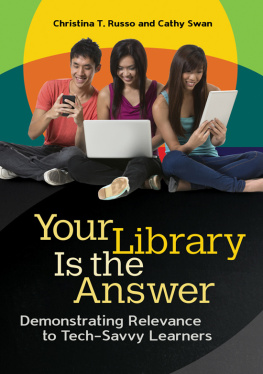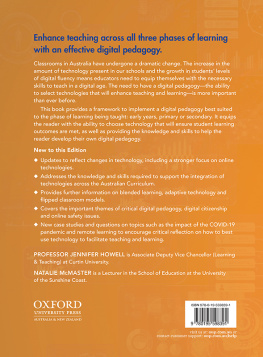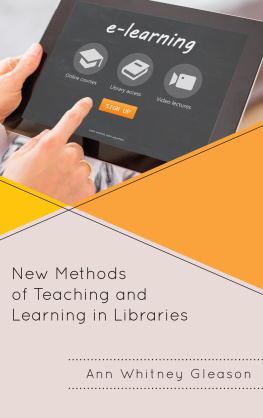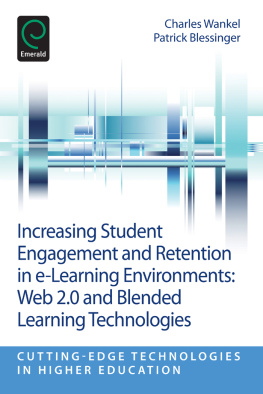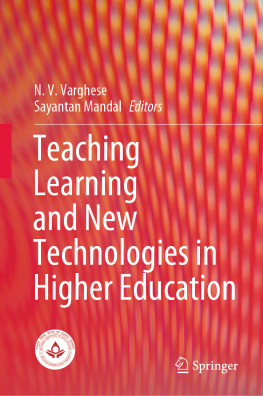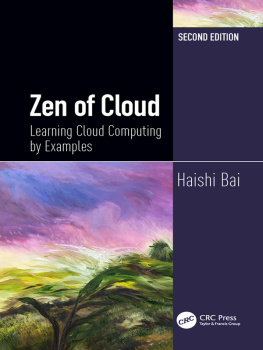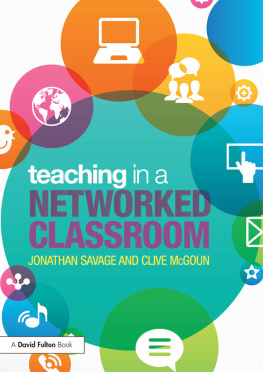Your Library Is the Answer
Your Library Is the Answer
Demonstrating Relevance to Tech-Savvy Learners
Christina T. Russo and Cathy Swan

Copyright 2015 by ABC-CLIO, LLC
All rights reserved. No part of this publication may be reproduced, stored in a retrieval system, or transmitted, in any form or by any means, electronic, mechanical, photocopying, recording, or otherwise, except for the inclusion of brief quotations in a review, without prior permission in writing from the publisher.
Library of Congress Cataloging-in-Publication Data
Russo, Christina T., author.
Your library is the answer : demonstrating relevance to tech-savvy learners / Christina T. Russo and Cathy Swan.
pages cm
Includes bibliographical references and index.
ISBN 978-1-59884-933-2 (pbk : alk. paper) ISBN 978-1-59884-934-9 (eBook) 1. School librariesAims and objectivesUnited States. 2. School librariesUnited StatesEvaluation. 3. School librariesInformation technologyUnited States. 4. Internet in school librariesUnited States. 5. Online social networksLibrary applicationsUnited States. 6. School librariansEffect of technological innovations onUnited States. 7. School librarian participation in curriculum planningUnited States. I. Swan, Cathy, author. II. Title.
Z675.S3R87 2015
027.80973dc23 2014037460
ISBN: 978-1-59884-933-2
EISBN: 978-1-59884-934-9
19 18 17 16 15 1 2 3 4 5
This book is also available on the World Wide Web as an eBook.
Visit www.abc-clio.com for details.
Libraries Unlimited
An Imprint of ABC-CLIO, LLC
ABC-CLIO, LLC
130 Cremona Drive, P.O. Box 1911
Santa Barbara, California 93116-1911
This book is printed on acid-free paper 
Manufactured in the United States of America
Excerpts from Generation M2: Media in the Lives of 8- to 18-Year-Olds, (#8010), The Henry J. Kaiser Family Foundation, January 2010. This information was reprinted with permission from the Henry J. Kaiser Family Foundation. The Kaiser Family Foundation is a non-profit private operating foundation, based in Menlo Park, California, dedicated to producing and communicating the best possible analysis and information on health issues.
Excerpts from Lemov, Doug. Teach Like a Champion: 49 Techniques that put Students on the Path to College . San Francisco: Jossey-Bass, 2010 and Wagner, Tony, Robert Kegan, Lisa Lahey, Richard W. Lemons, Jude Garnier, Deborah Helsing, Annie Howell, and Harriette Thurber Rasmussen. Change Leadership: A Practical Guide to Transforming Our Schools . San Francisco: Jossey-Bass, 2006 are reprinted with permission.
Could you meet the Pizza Hut challenge? Pizza Hut announced that it would hold 140-second interviews for the position of manager of digital media. Wow140 seconds to sell yourself! Pizza Hut advertised for someone who could communicate clearly in a short amount of time, be on the cutting edge of social space, be super passionate, and quick on their feet (Wong, 2013). This person must be knowledgeable about a variety of social media platforms and information outlets, as well as have the ability to think creatively and motivate others. What they need is a school librarian. Yes, a school librarian not only can do all this, but can do it seamlessly. A six-word memoir, a six-second video, or a 140-character tweet poses no problem for these tech savvy professionals, who actively participate in and construct new media daily. They not only can meet the Pizza Hut challenge, but can exceed it because of their disposition, breadth of knowledge, and responsiveness. They are a perfect fit for the fast-paced, media driven, connected marketplace.
But the real question is whether students are ready. Nearly 50 percent of all known occupations will be obsolete because of computerization and automation in the next few years, according to Carl Benedikt Frey and Michael A. Osborne in The Future of Employment: How Susceptible Are Jobs to Computerization? With the advent of Web 3.0, quantum computing, tap and pay, and a host of other technological innovations, curiosity and creativity define the new marketplace skills.
An excellent school librarian possesses, models, and teaches the 21st-century habits of mind necessary to meet the challenges of computerization and automation, as well as exceeds the Pizza Hut challenge:
Innovative, imaginative, and creative
Communicates effectively
Thinks critically and flexibly, using metacognition
Adapts
Multitasks
Questions (with intent)
Persists
Is accurate
Collaborates
Takes responsible risks (Costa, 2008)
These habits of mind are natural catalysts for 21st-century learning and a positive school environment: culture, climate, conditions, and the integration of cutting-edge technology, as well as employment viability.
Librarians are transformational leaders because of their natural curiosity, creativity, and analytical reasoning. They imagine new solutions, propose new ideas, and institute new practices to construct powerful learning experiences for the connected students to excel at college and in the global marketplace.
Creativity, content, and connectivity knowledge highlight the importance of their multidimensional role: information broker, technology integrator, collection developer, cataloger, curator, researcher, mashup developer, collaborator, creative risk-taker, organizer, analytical decision maker, and, most important, passionate, innovative teacher. Study after study supports the role of the school librarian as a positive force in 21st-century learning and student achievement (Francis, Lance, and Lietzau, 2010; Lance, Rodney, and Hamilton-Pennel, 2005; Todd and Kuhlthau, 2005).
As information, communication, and technologies (ICT) experts, they teach questioning, gathering, selecting, evaluating, interpreting, synthesizing, and communicating in a variety of formats and on a range of platforms, all while modeling creative and critical thinking. Not only do they do this, but they do it strategically, collaboratively, ethically, and efficiently.
As coteachers, they see learning as an act of social participation... through the belief that interactive, digital, and networked forms of media are supporting new forms of engagement with knowledge and culture with unique learning dynamics (Jenkins et al., 2006).
Although the vast majority of school librarians can easily meet the Pizza Hut challenge and are on the cutting edge, the question of relevancy sometimes rears its ugly head. The following scenarios illustrate why relevancy is sometimes questioned and intensify the need to examine the role of school librarians for educational reform and lifelong learning.
During an accreditation site visit to another school, a school librarian overheard two members of the evaluation team express very different views of the role of librarians in their school. One teacher stated, librarians are like blacksmithsthey are no longer important. The teacher further exclaimed, Students have access to the Internetits a waste of money to buy books and magazines for a library. Another teacher stated, I collaborate with my librarian all the time. We work together on all kinds of assignments. Our library is always busykids use it constantly.
How do two educators have such differing points of view on the role of librarians as instructional partners and teachers, the integration of library resources for learning, and the use of tax dollars for the purchase of library books, databases, and other vital resources for students? Is there a difference in the demographics or the educational philosophy or mission of these two educators schools?
Next page
